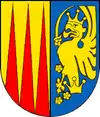Želiezovce
Želiezovce (Hungarian: Zselíz, (formerly) Zseliz (till 1895), Zeliz, Zeléz, German: Zelis (rare)) is a town in Slovakia in the Nitra Region in the Levice District, near the Hron river.
Želiezovce
Zselíz | |
|---|---|
Town | |
 | |
 Coat of arms | |
 Želiezovce Location in Slovakia | |
| Coordinates: 48°02′55″N 18°39′37″E | |
| Country | Slovakia |
| Region | Nitra |
| District | Levice |
| First mentioned | 1274 |
| Government | |
| • Mayor | András Juhász |
| Area | |
| • Total | 56.523 km2 (21.824 sq mi) |
| Elevation | 137 m (449 ft) |
| Population (2018-12-31[1]) | |
| • Total | 6,772 |
| • Density | 120/km2 (310/sq mi) |
| Time zone | UTC+1 (CET) |
| • Summer (DST) | UTC+2 (CEST) |
| Postal code | 937 01 |
| Area code(s) | +421-36 |
| Car plate | LV |
| Website | www.zeliezovce.sk |
Districts
- Jarok (Hungarian: Nyitra-Ivánka)[2]
- Karolína
- Mikula (1967 established) (Hungarian: Garam-Mikola)[3]
- Rozina (Hungarian: Rozina major), named after Rozina Esterházy (Festetics) (1779 - 1854)
- Svodov (1976 established) (Hungarian: Szodó, Szódó, Yiddish: Sudov)
- Veľký Dvor (Hungarian: Kerek-Udvardi puszta)[4]
- Želiezovce
History
The territory of the settlement was inhabited as early as the Bronze Age, the Quadi period and the Great Moravian period. The town was first mentioned in 1274. It was heavily damaged at the end of World War II.
Archeology
The town gave name to the archeological Želiezovce group (named after a find in Veľký Pesek, now part of the village Sikenica, which was part of Želiezovce in 1986-1992).
St James Church
The most notable monument of Želiezovce is the medieval church of St James the Greater, situated in the town centre. It was built in its current form in the mid-fourteenth century, combining a polygonal apse with a single nave. The building has been richly decorated with at least four different layers of wall painting, which survive from the late fourteenth and early fifteenth centuries. The original context of these murals has been analysed in detail in the recent monograph (2018) by Krisztina Ilko, "The Medieval Wall Paintings of the Church of St James in Želiezovce."[5] Ilko has investigated how the wall paintings were connected to the patronage of the Becsei family who intended to develop a new dynastic seat in Želiezovce. The focal point of this research was the unique iconography of a fresco from the 1380s in the apse which depicts a celestial trial for the departing soul of the local landlord and knight George Becsei. Other surviving murals include a Man of Sorrows on the south-eastern wall of the apse, St Catherine in a sedilia in the nave, and SS Martin and Leonard of Noblac further down on the south wall of the nave.
Demographics
According to the 2001 census, the town had 7,522 inhabitants. 51.25% of inhabitants were Hungarians, 47.10% Slovaks, 0.55% Roma and 0.49% Czechs.[6] The religious make-up was 61.27% Roman Catholics, 18.43% people with no religious affiliation, and 6.37% Lutherans.[6]
Features

The town is known for a former Neoclassical residence of Count Johann Karl Esterházy, where the Austrian composer Franz Schubert taught music to the Count's daughters Maria and Karoline in the summers of 1818 and 1824. Apart from a nice large park, there is another important building: the Schubert House or Owl Chateau (Slovak: Soví zámoček, Magyar: Baglyosház), where Franz Schubert stayed, and composed some of his works. Finally, the town features a Gothic Catholic church, severely damaged in 1945.
People
- Franz Schubert, wrote his Grand Duo and Marche militaire here
- Eduard Sacher, born here (de)
- Timea Majorova, lived here
Twin towns — sister cities
Želiezovce is twinned with:[7]
 Miercurea Ciuc, Romania
Miercurea Ciuc, Romania Makó, Hungary
Makó, Hungary Barcs, Hungary
Barcs, Hungary Trstená, Slovakia
Trstená, Slovakia
References
- "Population and migration". Statistical Office of the Slovak Republic. Retrieved 2019-04-16.
- Krisztina Ilko: Stredoveké nástenné maľby kostola svätého Jakuba staršieho v Želiezovciach, 2018, o. z. Georgius Bubek, Rožňava, ISBN 978-80-972888-1-5.
- "Municipal Statistics". Statistical Office of the Slovak republic. Archived from the original on 2007-02-07. Retrieved 2007-02-10.
- "Partnerské mestá". zeliezovce.sk (in Slovak). Želiezovce. Retrieved 2019-09-09.